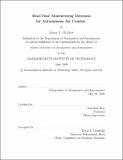| dc.contributor.advisor | Jonathan How. | en_US |
| dc.contributor.author | McGrew, James S | en_US |
| dc.contributor.other | Massachusetts Institute of Technology. Dept. of Aeronautics and Astronautics. | en_US |
| dc.date.accessioned | 2009-03-20T19:32:46Z | |
| dc.date.available | 2009-03-20T19:32:46Z | |
| dc.date.copyright | 2008 | en_US |
| dc.date.issued | 2008 | en_US |
| dc.identifier.uri | http://hdl.handle.net/1721.1/44927 | |
| dc.description | Thesis (S.M.)--Massachusetts Institute of Technology, Dept. of Aeronautics and Astronautics, 2008. | en_US |
| dc.description | This electronic version was submitted by the student author. The certified thesis is available in the Institute Archives and Special Collections. | en_US |
| dc.description | Includes bibliographical references (p. 127-129). | en_US |
| dc.description.abstract | Unmanned Aircraft Systems (UAS) have the potential to perform many of the complex and possibly dangerous missions currently flown by manned aircraft. Within visual range air combat is an extremely difficult and dynamic aerial task which presents many challenges for an autonomous UAS. An agile, unpredictable, and possibly human-piloted adversary, coupled with a complex and rapidly changing environment, creates a problem that is difficult to model and solve. This thesis presents a method for formulating and solving a function approximation dynamic program to provide maneuvering decisions for autonomous one-on-one air combat. Value iteration techniques are used to compute a function approximation representing the solution to the dynamic program. The function approximation is then used as a maneuvering policy for UAS autonomous air combat. The result is an algorithm capable of learning a maneuvering policy and utilizing this policy to make air combat decisions in real-time. Simulation results are presented which demonstrate the robustness of the method against an opponent beginning from both offensive and defensive situations. The results also demonstrate the ability of the algorithm to learn to exploit an opponent's maneuvering strategy. Flight results are presented from implementation on micro-UAS flown at MIT's Real-time indoor Autonomous Vehicle test ENvironment (RAVEN) demonstrating the practical application of the proposed solution in real-time flight with actual aircraft. | en_US |
| dc.description.statementofresponsibility | by James S. McGrew. | en_US |
| dc.format.extent | 129 p. | en_US |
| dc.language.iso | eng | en_US |
| dc.publisher | Massachusetts Institute of Technology | en_US |
| dc.rights | M.I.T. theses are protected by
copyright. They may be viewed from this source for any purpose, but
reproduction or distribution in any format is prohibited without written
permission. See provided URL for inquiries about permission. | en_US |
| dc.rights.uri | http://dspace.mit.edu/handle/1721.1/7582 | en_US |
| dc.subject | Aeronautics and Astronautics. | en_US |
| dc.title | Real-time maneuvering decisions for autonomous air combat | en_US |
| dc.type | Thesis | en_US |
| dc.description.degree | S.M. | en_US |
| dc.contributor.department | Massachusetts Institute of Technology. Department of Aeronautics and Astronautics | |
| dc.identifier.oclc | 309353804 | en_US |
